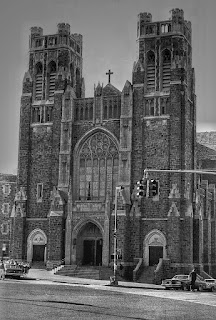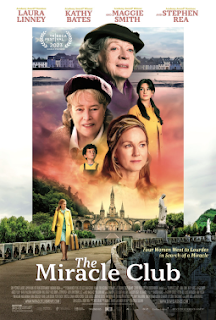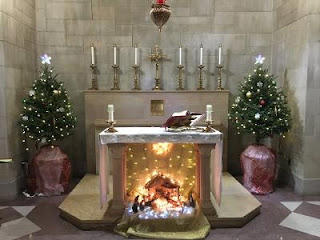On this date, June 25, in 1961, I graduated from 8th grade. By coincidence, exactly four years later in 1965, again on this date, I graduated from high school. Both schools were connected with my home parish in the Bronx. I had attended our parish elementary school and then our parish high school, both within walking distance of home and in the dominating shadows of our parish church’s great gothic towers (photo). Both elementary school and high school aimed to replicate the solidity of those towers, within the sheltered embrace of post-war Catholic complacency and optimism.
But surely teaching anywhere from 50 to 60 kids five days each week had to be a real challenge. Some of my teachers were older and quite experienced. Others obviously were less so. In at least one instance, we were one teacher’s very first class. The amazing thing, I think, about the parochial school system in those days was that putting a girl in a habit and sending her into a crowded classroom right out of novitiate and expecting her to control and teach a class of more than 50 kids somehow managed to work – and, on balance, really worked surprisingly well. As I remarked on this site at the time of my 50th High School reunion in 2015, the schools did their job and, in some respects, very well. Again, what made it all work so well was that it was so completely coherent with the rest of our world. Unlike later generations of parents, adults at that time fully supported the school, certainly valued the Sisters, and almost always sided with them.
Ours was a world of clearly defined moral rules and social expectations, starting with gender roles and family life and moving onward and outward from there. It is now much more widely acknowledged that not everyone benefitted equally from those rules and expectations. For some of us, certainly, some of those burdens seemed in the end to outweigh their benefits. But, for many if not most, at least at that time, the burdens still seemed bearable and paid off as guideposts toward a reasonably predictable and stable way of life. In the half-century and more that followed, enormous economic and cultural changes would eviscerate the opportunities available for such communities of working class people with modest educational background and radically diminish their prospects for financial and social stability in successfully functioning families. Social change always has winners and losers; and, in this case, there have certainly been lots of losers. And 21st-century America is paying a price for the alienation those losses produced.
Chris Matthews once said of Pat Buchanan: “To Pat, the world can never be better than the one he grew up in as a young boy … the United States of America of the early 1950s.” In fact, there was quite a lot that was very wrong about 1950s America and needed fixing. For all its limits, however, nostalgia for the limited and parochial world we have lost should remind us that liberation, if that is what it was, has come at its own heavy price. There was much to admire in that less liberated world, much that was nurturing and nourishing and supportive and strengthening, the loss of which has diminished us as a society.
Long division aside, some subjects were new in 4th grade – history and geography, for example. From then on, each September when school resumed and we got our new textbooks, I would eagerly read ahead through the entire history book, so eager was I to learn, so in love was I with other times, other places, and other possibilities. Commendable though that may have been as an intellectual interest, it perhaps also suggested some fundamental unhappiness with my present personal situation, that I, as yet, of course, had no proper vocabulary to express.
Much of what made the Bronx beautiful (and its parish neighborhoods such great places to live and to grow up in) is now gone forever. But the University Heights Fordham section of the Bronx remains still a bustling commercial and residential urban area, and the beautiful church still stands as the neighborhood’s beating heart – still serving a diverse population, only now with Masses in two other languages!
Whenever a priest came into the classroom to speak either to us or to our teacher, one of us would be expected to reverently request his priestly blessing. Then we would all (including Sister) dutifully drop to our knees while Father raised his hands in a semicircle and then made the sign of the cross over us, saying Benedicat vos omnipotens Deus, Pater, et Filius, et Spiritus Sanctus. Meanwhile, from the daily Rosary in October, decorating the crib before Christmas, and making the Stations of the Cross on Fridays in Lent, all the way to Mary’s annual May Crowning, the calendar followed a set cycle of taken-for-granted devotions that punctuated the year and marked the recurring rhythm of months and seasons.
And, of course, there were the special life-cycle celebrations, such as First Confessions, First Communion, and Confirmation, for which the school faithfully prepared us. Thus, on Saturday, June 4, 1955, at an 8:00 a.m. Solemn High Mass, having now officially reached the “age of reason,” I made my First Communion – after (as was the norm at the time) having made my First Confession the day before. Lover of ritual and ceremony that I already was, what I actually remember most about my First Communion was all the hours we spent practicing beforehand. The Sisters were not about to leave anything to chance! I remember how we walked up to the altar, two-by-two, and then how I returned to my pew with my hands held together very piously – something which my father thought noteworthy enough to comment on later. I also remember my mother’s dress as she approached the Communion rail later on in the Mass. (In those days, when most adults still went to Communion only occasionally, First Communion was one of those relatively rare events when one’s parents would be expected to go to Communion.)
As for the actual reception of Communion itself – kneeling on the altar step to receive the sacred Host on my tongue, as the priest prayed, Corpus Domini nostri, Jesu Christi custodiat anuman tuam in vitam aetaernam, Amen – that memory seems surprisingly less vivid. Perhaps that is because it merges in memory with so many other subsequent receptions of Communion. That may be as it should be. As I always later liked to stress when preaching to First Communicants on their big day, the key word to remember about the experience is “first” – the first time they are doing what (hopefully) they are going to be doing many more times, over and over again, at least once each week, all the rest of their lives.
The other significant life-cycle sacrament was, of course, Confirmation, which I received in the 5th grade on Sunday, September 22, 1957. In more recent years, the optimal age for confirmation has occasioned much (more or less, pointless) debate. In those days, the optimal age was whenever there was a Bishop available to do it. I was confirmed at the beginning of 5th grade. Had I not been “skipped,” I would have been in the 4th grade and would have been confirmed with my original class.
I’ve seen my 1st Communion and Confirmation pictures so many times that it is hard to know for sure what is actual memory and what is induced memory. I certainly can remember memorizing beforehand the Catechism answer that the sacrament of Confirmation made us “strong and perfect Christians and soldiers of Jesus Christ,” and that “sacred chrism is a mixture of olive oil and balsam blessed by the Bishop on Holy Thursday.” And I remember asking for turkey to be served at the family party afterwards. As for the ceremony itself, I remember carrying a card between my fingers with my confirmation name on it. I remember a priest then taking the card and saying the name to the Bishop (in what I later would learn to identify as the nominative case) and then the Bishop addressing me (in what I would later learn was the vocative case): Michael, Signo te signo crucis; et confirmo te chrismate salutis. In nomine Patris, et Filii, et Spiritus Sancti.
Much more important than confirmation in my life at that time was becoming an altar boy. In those days, it was considered a great privilege (albeit a widely shared one) to serve at Mass. Several afternoons that 5th-grade fall of 1957, my classmates and I eagerly assembled where we practiced the complex maneuvers of moving the missal from the epistle side of the altar to the gospel side and then back again, carrying (and kissing) the cruets with the wine and water, ringing the bells, carrying the communion plate while walking with the priest at the altar rail, and so much more. And, of course, there was the Confiteor, the Suscipiat, and all the other Latin responses to memorize, starting with the wonderful psalm response at the foot of the altar: Ad Deum qui laetificat juventutem meam!
Serving as an altar boy – at Sunday Masses, weekday Masses, Low Masses, Sung Masses, Nuptial Masses, Funeral Masses, Benediction of the Most Blessed Sacrament, Stations of the Cross, Forty Hours, and the crowning event for me as an 8th grader, serving as the thurifer at Christmas Midnight Mass – was among the more unambiguous joys of my parochial school boyhood.
Obviously, ours was a thoroughly Catholic environment. At the time, the United States was still perceived primarily as a predominantly Protestant country. Electing a Catholic president in 1960 was still quite controversial. (I remember reading Episcopal Bishop James A. Pike’s nasty book A Roman Catholic in the White House? one day at the public library.) There seemed to be hardly any Protestants in my neighborhood – at least none I knew of. Jews, however, were another story. Jews were very visible in New York, a vital and vibrant our urban mix. So I grew up much more aware of Jews and Judaism than I might otherwise have been. This had nothing to do with ecumenism or inter-religious dialogue (about which we knew nothing), but it had everything to do with the close character of urban neighborhood life and the natural human solidarity it enabled and encouraged.
Even at that late date in modern history, ours was still a naively pre-secular environment, in which irreligion or indifference to religion was simply not yet recognized as a viable option. (That there were some people in the world for whom it was an option – for example, Communists – was something of which I was certainly aware, but that irreligion or indifference to religion might become an option for me and people like me, that was not yet consciuously recongized.)
Our principal liked to say that one should learn as much in four years of high school as in eight years of elementary school. I suppose that, at first, I certainly did find high school more academically challenging than what I had been used to, but I quickly adapted and did well enough. In retrospect, I think of high school as ultimately more about socialization than education. Unfortunately, I was less adept at the former than the latter.
We also took lots of standardized tests, which were all the rage at the time and were especially loved by our principal, who aspired through them to heighten the academic standard of our small parish high school. We took the National Educational Development Test, the Iowa Test of Educational Development, the National Merit Scholarship Test, and the PSAT. Good practice, perhaps, for the actual SAT (and later the GRE, but not indicative of much else in my opinion.
Unlike the many exclusively all boys’ or all girls’ Catholic schools, our high school was what was then called “co-institutional.” In a “co-institutional” school, both boys and girls were enrolled and shared the same building, but in separate “Departments.” The « Boys’ Department » was staffed by Augustinian priests, augmented by additional laymen on the faculty. The « Girls’ Department » had, I believe, nine Sisters, likewise augmented, I suppose, some laywomen on the faculty. These « Departments » were in effect separate schools, each with its own separate faculty and administration, its own separate entrance and stairway, separate lunch periods, and, of course, completely separate classes in our separate sections of the building. Like most things then as now, that arrangement had its advantages and its disadvantages, as any academic arrangement inevitably does. I believe that single-sex education may well relieve the students of certain competitive pressures, but I also wonder whether a more “normal” environment might have helped some of us better develop some seriously needed social skills. On the other hand, maybe it would not have mattered much in the end anyway.
Other than attendance at school Masses and the annual Holy Week retreat in the lower church, one of the very few official school activities in which boys and girls participated together was the annual school musical. These were light-hearted musical reviews, with corny titles like Just for Kicks (“JFK”) in 1961 and Mad About Manhattan in 1962. Being in the “chorus” of those shows every year was for me one of the highlights of the spring term. To be sure, I didn’t discover any latent talent, but I had a great time and genuinely enjoyed the whole collaborative project, both rehearsals and performances, as well as the “cast party” on the final night, at which one of my favorite priest-teachers would get up and sing The Chattanooga Choo-Choo. (Who would have imagined then that half a century later the actual Chattanooga Choo-Choo would become a hotel and conference center, and that I would stay there during the annual Priests’s convocation of the Diocese of Knoxville, TN?)
Meanwhile, the outside world seemed to be getting more and more turbulent. These were the years of the Civil rights movement – the sit-ins, the freedom riders, the very visible (watched-on-TV) challenge to an unjust, but too long-accepted state of affairs in our country. My high school had exactly one black student. And it is a reflection of both what was good and what was problematic about that narrow cultural enclave that our high school principal talked frankly about the difficult decision to admit the school’s first black student but how in the end he had done what seemed to him to be the right thing to do.
Meanwhile, my high school classmates were beginning to align themselves politically. The 1963-1964 school year saw the emergence of some very vocal Goldwaterites in my class. My own allegiance at that time was primarily pro-civil rights, and thus I would probably have been classified as a moderate-to-liberal Democrat. At home, I started watching the new half-hour network news show in the evenings and read and thought seriously (or what I thought of as seriously) about politics and international affairs.
But, of course, the defining national trauma of my high school years came one year later. We were in English class on Friday afternoon, November 22, 1963. It was the last period, and the principal had already made the customary end-of-day announcements over the loudspeaker. Suddenly, he came back on and said, “We ask you to remember in your prayers …” I immediately thought that some student’s parent had died or was seriously sick, because that was how such announcements usually began. But then he continued, “… the President of the United States, who has been shot.” Our English teacher looked up and said, “I thought they didn’t do that in this country.” As we walked home from school, a group of us talked somberly about what had happened and what would happen with a new president. I went straight upstairs – no lingering that day. My Italian-speaking grandmother told me that the President had been shot. I told her I’d already heard and then turned on the TV, where I heard the announcement, “John Fitzgerald Kennedy, the 35th President of the United States, is dead.” I then went back to my grandmother and told her, “E morto, il presidente è morto.”
Like Caesar’s ancient Gaul, I look back on the 1960s as divided into three parts – the “Camelot” sixties that ended so dramatically in Dallas in 1963, the “Great Society” sixties that lasted until the “off-year” election of 1966, and then the revolutionary sixties the highpoint of which was the terrible (but so exciting to have lived through) year 1968, after which the sixties seemed to limp on to a somewhat tepid and inglorious end in the Nixon years, by which time I had left high school, the parish, and the neighborhood behind for the more challenging education offered by New York’s City College and the very different ambience of living on my own in Manhattan.
The Church was changing too. In 1959, when I was in 6th grade, the newly elected Pope John XXIII announced his intention to convoke an ecumenical council. Because I was in school in the run-up to the Council, I certainly heard a lot more about it than my parents did, but I suspect that my expectations (if in fact I had any expectations) were no less limited. My freshman year High School Yearbook in the spring of 1961, several months before the Council’s opening, was dedicated to John XXIII and his Council. It included a Prayer for the Success of the Council, which contained this curious petition: “Grant that they may be vigilant, united among themselves, not seeking the triumph of some idea which is dear to a group of men, a nation, a Religious Order, but only to follow with docility the inspiration of your grace.”
In fact, the Council was to be the Church’s equivalent of the Camelot and Great Society Sixties, which inadvertently got sucked into the all-absorbing vacuum created by the revolutionary sixties, which then spewed back a weakened, conflicted, and divided Church, shorn of confidence in itself at the precise historical moment when such self-confidence on the Church’s part would be sorely needed and sorely missed. But that is a story of another, later time. Graduating high school on this date in 1965, most of us were still complacently unaware of how those apparently external social struggles and cultural transformations would not only change our own individual live but would also bring to a traumatic end that superficially placid, narrow, parochial world I had grown up and attended school in.
That said, as the philosopher Charles Taylor has written (A Secular Age, Harvard U. Pr., 2007), « Our past is sedimented in our present, and we are doomed to misidentify ourselves, as long as we can’t do justice to where we come from. »




